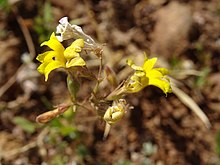Goodenia berringbinensis
Goodenia berringbinensis is a species of flowering plant in the family Goodeniaceae and is endemic to Western Australia. It is an annual herb with lance-shaped leaves mostly at the base of the plant, and loose thyrses of yellow flowers.
| Goodenia berringbinensis | |
|---|---|
 | |
| Scientific classification | |
| Kingdom: | Plantae |
| Clade: | Tracheophytes |
| Clade: | Angiosperms |
| Clade: | Eudicots |
| Clade: | Asterids |
| Order: | Asterales |
| Family: | Goodeniaceae |
| Genus: | Goodenia |
| Species: | G. berringbinensis |
| Binomial name | |
| Goodenia berringbinensis | |
Description
Goodenia berringbinensis is an annual herb that typically grows to a height of 300 mm (12 in), with softly-hairy foliage. The leaves are mostly at the base of the plant, lance-shaped with the narrower end towards the base, 35–60 mm (1.4–2.4 in) long and 2–10 mm (0.079–0.394 in) wide, sometimes with small teeth on the edges. The flowers are arranged in loose thyrses up to 150 mm (5.9 in) long on a peduncle 5–30 mm (0.20–1.18 in) long, each flower on a pedicel 13–20 mm (0.51–0.79 in) long with a linear to elliptic bracts 4–15 mm (0.16–0.59 in) long at the base. The sepals are lance-shaped, about 3 mm (0.12 in) long, the corolla yellow, about 12 mm (0.47 in) long. The lower lobes of the corolla are 4–5 mm (0.16–0.20 in) long with wings about 2 mm (0.079 in) wide. Flowering has been observed in October and the fruit is a more or less cylindrical capsule about 8 mm (0.31 in) long.[2][3][4]
Taxonomy and naming
Goodenia berringbinensis was first formally described in 1990 by Roger Charles Carolin in the journal Telopea from material collected by Charles Gardner in the bed of Berringbine Creek on Belele Station in 1945.[5] The specific epithet (berringbinensis) refers to the type location.[4]
Distribution and habitat
This goodenia grows along watercourses in scattered locations in the Coolgardie, Gascoyne, Murchison, Pilbara and Yalgoo biogeographic regions of Western Australia.[3]
Conservation status
Goodenia berringbinensis is classified as "Priority Four" by the Government of Western Australia Department of Parks and Wildlife,[3] meaning that it is rare or near threatened.[6]
References
- "Goodenia berringbinensis". Australian Plant Census. Retrieved 17 December 2020.
- Carolin, Roger C. "Goodenia berringbinensis". Australian Biological Resources Study, Department of Agriculture, Water and the Environment: Canberra. Retrieved 25 December 2020.
- "Goodenia berringbinensis". FloraBase. Western Australian Government Department of Parks and Wildlife.
- Carolin, Roger C. (1990). "Nomenclatural notes and new taxa in the genus Goodenia (Goodeniaceae)". Telopea. 3 (4): 537–538. doi:10.7751/telopea19904905. Retrieved 25 December 2020.
- "Goodenia berringbinensis". APNI. Retrieved 25 December 2020.
- "Conservation codes for Western Australian Flora and Fauna" (PDF). Government of Western Australia Department of Parks and Wildlife. Retrieved 25 December 2020.
